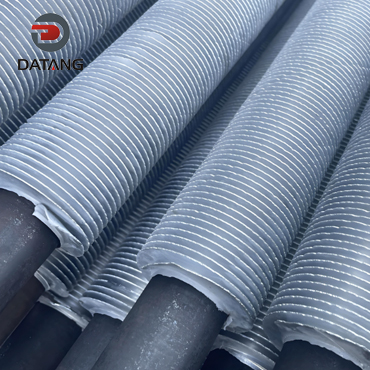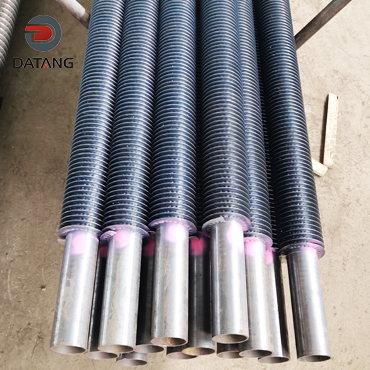What is a Composite Finned Tube?
Composite finned tubes are heat transfer components that utilize two or more fin treatments to enhance heat transfer. They are made by combining a carbon steel, stainless steel, or copper base tube with aluminum fins through a rolling process, combining the performance advantages of different metal materials.
The main production processes for composite finned tubes include rolling and welding. The rolling method optimizes fin height by adjusting the reduction and tube wall thickness, reducing contact thermal resistance and improving structural stability.


This product incorporates strengthening technologies such as louvered slits and delta-wing longitudinal vortex generators. It must be corrosion-resistant, wear-resistant, and resistant to dust accumulation. It is used in oil refining, chemical processing, power generation, and waste heat recovery systems. In intercooler applications, poor fin welding can occur due to improper brazing process matching.
The most widely used finned tubes in air conditioners are copper tubes with inner and outer fins. While these tubes offer excellent heat transfer performance, they also consume a lot of copper, leading to increased production costs.
Composite finned tubes were developed to meet these needs. Combining the advantages of both composite and finned tubes, they are a new type of high-efficiency heat transfer tube currently being widely researched internationally. Composite radial finned tubes with aluminum outer and stainless steel inner fins are produced by rolling, while composite axial finned tubes with aluminum outer and stainless steel inner fins are produced by welding.
Composite fins
Composite fins utilize two (or more) different treatments to enhance heat transfer. Their key feature is the ability to integrate the advantages of different enhancement methods within a single fin, resulting in better overall performance. The addition of delta wings to louvered slotted fins, acting as longitudinal vortex generators, and structural optimization have shown that this fin design improves heat transfer performance by 39% and reduces drag by 23% compared to conventional louvered fins.
A turbulence model was used to analyze the heat transfer of corrugated fins and corrugated fins with right-angled triangular winglets. The longitudinal vortices generated by the triangular winglets significantly improved heat transfer in the wake region. Heat transfer was enhanced by 13.1% and 7.0% in the staggered and parallel arrangements, respectively, but drag increased by 15.4% and 10.5%, respectively.
Bimetallic rolled fin tubes consist of a base tube (usually made of carbon steel, stainless steel, or copper) and fins wrapped around it. The base tube is then sheathed with an aluminum tube. The aluminum tube is then extruded into the fins using a specialized rolling mill. A thin underlayer is then formed around the base tube to tightly encase it.
Main Advantages of Bimetallic Finned Tubes
The base tube is steel, offering excellent mechanical properties, temperature resistance, pressure resistance, and corrosion resistance.
The outer layer is aluminum, which is lightweight, inexpensive, easy to process, has good atmospheric corrosion resistance, and an attractive appearance.
The fins are strong and can withstand high-pressure flushing and descaling.
The contact thermal resistance between the fins and the base tube does not increase due to corrosion and oxidation of the base tube. The heat transfer performance is slightly better than that of wound-fin tubes, leading to their increasing application, particularly in the oil refining, chemical, and power generation industries.
The Mechanism of Fin-Enhanced Heat Transfer
The air side of a fin-and-tube heat exchanger primarily utilizes convection heat transfer. Convection heat transfer enhancement technologies can be categorized as either passive or active.
Passive technologies require no additional power beyond that required to support fluid flow. Active technologies rely on external power to achieve enhanced heat transfer.
Passive enhancement technologies primarily include:
Surface treatment (perforated or serrated surfaces), roughened surfaces, extended surfaces, flow turbulence elements, vortex generators, spiral tubes, surface tension elements (special structures on the heat transfer surface, such as porous structures), and additives (adding special additives to the fluid).
Active enhancement technologies primarily include: mechanical agitation, surface vibration, fluid vibration, electromagnetic fields, injection or suction, and jet impingement.
Currently, heat transfer enhancement fins primarily utilize passive technologies to enhance convective heat transfer on the fluid side. The physical mechanisms of convective heat transfer enhancement can be summarized as follows:
a. Enhanced mixing of the fluids at the wall and in the center;
b. Thinning of the boundary layer;
c. Formation of secondary flows and increased turbulence.
In fin-and-tube heat exchangers, the flow regime can be categorized as laminar or turbulent. The fins’ heat transfer enhancement mechanisms and methods vary under different flow regimes. In laminar flow, the velocity and temperature distributions of the fluid are parabolic, and the temperature gradient between the fluid and the wall occurs across the entire flow cross-section. Therefore, the main approach to enhancing laminar heat transfer is to induce strong radial mixing of the fluid, improve the uniformity of the velocity and temperature fields in the core region, and thereby increase the temperature gradient at and near the wall, thereby enhancing heat transfer.
In turbulent flow, the velocity and temperature fields in the core region are already relatively uniform, and the thermal resistance to convective heat transfer primarily exists in the viscous sublayer of the fluid adjacent to the wall. Therefore, the main approach to enhancing turbulent heat transfer is to disrupt the development of the boundary layer. This involves increasing the perturbation of the boundary layer to reduce the thickness of the laminar sublayer, allowing the heat transfer temperature difference to occur in the fluid layer closer to the wall, thereby enhancing heat transfer.
In fin-and-tube heat exchangers, since fan flow rates vary depending on the heat exchanger structure, the corresponding flow regimes can be both laminar and turbulent. Therefore, both laminar and turbulent models are applied when studying heat transfer enhancement fins, and the corresponding enhancement mechanisms are complex.
Composite Finned Tube Production Methods
Compound finned tube production methods primarily include welding and rolling.
Welding Method
Welding involves welding metal fins directly onto the outer surface of a bimetallic composite tube using a welding torch. This method allows for the production of composite finned tubes of varying sizes and materials, depending on product requirements. However, the presence of large amounts of oxides and impurities in the weld seam significantly reduces heat transfer efficiency, resulting in poor performance.
Rolling Method
Rolling Method: A mandrel is lined within the bimetallic composite tube. Driven by the rotating roller blades, the composite tube passes through the grooves and core head, creating fins on its outer surface. This method produces heat transfer tubes whose outer tube and fins are an integral unit, eliminating contact heat loss and resulting in excellent performance and high heat transfer efficiency. This experiment selected the three-roll rolling method to investigate composite finned tubes. The effects of rolling reduction, outer tube wall thickness, metal condition, and core head helix angle on the formation of the inner and outer fins were analyzed.
The Effect of Rolling Reduction
As rolling reduction increases, the outer fin height and inner rib height also increase. According to the laws of metal flow during rolling, increasing rolling reduction increases the depth of the blades’ penetration into the copper tube. Due to the constraints of the rolled shape, the radially compressed metal cannot flow axially and is forced to flow into the gaps between the roller blades, where resistance is lower. This increases the outer fin height.
As rolling reduction increases, the rolling pressure on the inner aluminum tube also increases. Under the influence of circumferential pressure, the radially compressed metal flows into the grooves of the inner spiral core, increasing the metal filling rate in these grooves and thereby increasing the inner rib height. Therefore, increasing rolling reduction helps increase the outer fin height and inner rib height of the finned tube, achieving the desired improved heat transfer performance.
It should be noted that a higher rolling reduction is not necessarily better. As the rolling reduction increases, the rolling force also increases. If this exceeds the deformation resistance of the outer metal, rolling will result in sticking. Furthermore, to ensure smooth assembly of the heat transfer tube, the outer diameter of the composite finned tube should be slightly smaller than that of the smooth tube blank. If the reduction is too large, the fin height will increase excessively, potentially exceeding the required performance.
Main Performance Requirements for Composite Finned Tubes
As heat exchange components, composite finned tubes operate in high-temperature flue gas conditions for extended periods. For example, finned tubes used in boiler heat exchangers operate in harsh environments with high temperatures, high pressures, and corrosive atmospheres. This requires the finned tubes to possess very high performance specifications. 1) Anti-corrosion
2) Anti-wear
3) Low contact resistance
4) High stability
5) Anti-dust deposition
The Impact of Tube Wall Thickness
Given the same outer diameter, inner tube wall thickness, and rolling reduction, a thicker outer tube wall requires less rolling reduction, allowing the composite tube wall to contact the core head. This reduces the remaining rolling reduction and concentrates the outer fins and inner ribs on the composite tube, leading to increased outer fin height and inner rib height. Tube wall thickness significantly affects outer fin height and has a limited impact on inner rib height.
To achieve higher outer fins and inner ribs, the tube wall thickness should be increased. However, this also significantly increases the wall thickness at the fin base, significantly reducing the heat transfer performance of the composite tube. Furthermore, increased tube wall thickness results in waste of raw materials, which in turn increases production costs.
Influence of original mechanical strength ratio
When the strength of the aluminum tube is greater, that is, the mechanical strength ratio is smaller, the height of the outer fin formed increases and the height of the inner rib decreases. This is because the greater the strength of the inner aluminum tube, the stronger its resistance to plastic deformation. Therefore, under the same rolling force, the height of the inner rib also decreases accordingly. However, the law that the height of the inner rib decreases with the increase of the strength of the aluminum tube is not very obvious. This is mainly because the formation of the inner rib is more difficult than the formation of the outer fin and is less affected by the deformation resistance.
On the contrary, the formation of the outer fin is easier and is greatly affected by the deformation resistance. The plastic deformation will be concentrated on the outer copper tube that is easier to deform.
In order to meet the requirements of thermal conductivity, in actual production, the metal state with a closer mechanical strength should be selected for rolling.
Failure of intercooler composite fin tube and brazing process problems
Irrational material selection and structural matching of intercooler composite fin tube and unreasonable process selection lead to frequent failures in the intercooler manufacturing process.
Main failure forms
(1) Poor welding of inner fins. The welding rate of inner fins is insufficient or almost no weld joint is formed.
(2) The welding rate of outer fins is insufficient, or the outer fins and the welded pipes are not welded.
Due to the above-mentioned poor welding, the intercooler cannot meet the use conditions. After installation, it fails prematurely under the action of internal high pressure, high temperature and pulse pressure. In severe cases, the intercooler fails before working for less than 20 hours.
The main reasons for these failures are:
(1) Unreasonable matching of brazing material and process. The brazing material layer of the intercooler composite fin tube can be selected from 4045 or 4343, but due to the different melting points of the two brazing materials, there are differences in brazing temperature and brazing time. Unreasonable brazing temperature and brazing time will inevitably cause weld defects.
(2) Unreasonable selection of material thickness, material state, etc. of the welded pipe, inner fins and outer fins, resulting in mismatched structural strength of the parts. There are gaps between the inner fins and the welded pipe, and between the outer fins and the welded pipe. During welding, the gaps are too large to be filled, resulting in a failure to form a normal weld.
(3) The dimensions of the welded pipe and fins are not designed properly. The internal width of the welded pipe is much larger than the height of the inner fins, resulting in a large gap between the inner fins and the inner wall of the welded pipe, causing poor welding.


